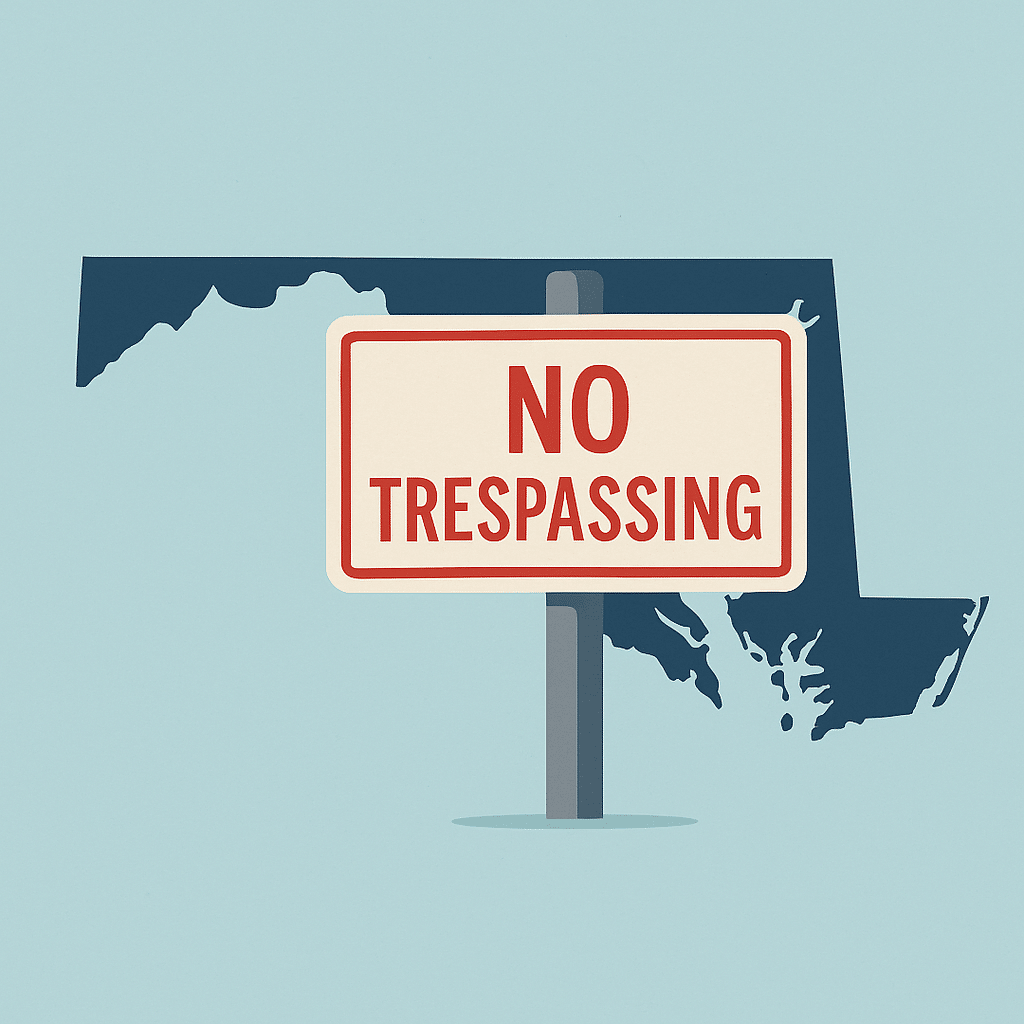
Trespassing laws in Maryland are governed by Title 6, Subtitle 4 of the Maryland Criminal Law Code, and they are more serious than many people realize. Whether you own property in Prince George’s, Charles, Calvert, or St. Mary’s Counties—or anywhere else in Maryland—understanding these laws can help you protect your rights and avoid criminal charges.
In this post, we’ll explain the main types of trespass offenses under Maryland law, what property owners must do to properly post their land, potential penalties, defenses, and what to do if you’re charged with trespassing.
Types of Trespass Under Maryland Law
Maryland recognizes several types of trespassing, each defined under a different section of the Criminal Law Article.
- Criminal Trespass on Posted Property (§6-402)
This is the most common form of trespass. A person may not enter or remain on property that is clearly marked with “No Trespassing” signs or approved paint markings indicating restricted access. - Wanton Trespass or Trespass After Notice (§6-403)
This occurs when a person is told—either verbally or in writing—not to enter or remain on certain property, but ignores the instruction. Direct notice from the owner or an authorized agent is sufficient. - Vehicle-Related and Specialized Trespasses (§§6-404 through 6-406)
Maryland law also prohibits:- Operating a vehicle on private property without permission
- Using off-road vehicles on public property
- Entering cultivated land or stable areas without consent
- Failure to Leave Public Buildings or Grounds (§6-409)
This applies to individuals who refuse to leave a public building, such as a courthouse, school, or government office, after being asked to do so.
Posting Requirements for Private Property
For a trespass charge under §6-402 to hold up in court, the property must be properly posted. Maryland law allows landowners to use either signs or blue paint markings to indicate restricted property.
- Signs must be placed in locations that can be easily seen by someone approaching the property.
- Paint markings must:
- Be vertical lines at least two inches wide and eight inches tall
- Be placed between three and six feet above the ground
- Use bright blue oil-based paint that is clearly visible
- Be placed at all road or waterway entrances and along property boundaries
If the property isn’t clearly marked, a trespassing charge under this section may be difficult for the state to prove.
Penalties for Trespassing in Maryland
Trespassing is generally a misdemeanor in Maryland. However, the penalties increase with repeated offenses.
| Type of Offense | Maximum Jail Time | Maximum Fine |
|---|---|---|
| First offense | Up to 90 days | Up to $500 |
| Second offense (within 2 years) | Up to 6 months | Up to $1,000 |
| Subsequent offenses (within 2 years) | Up to 1 year | Up to $2,500 |
Other forms of trespassing, such as entering school property or trespassing with intent to invade privacy, may carry enhanced penalties.
Defenses to Trespassing Charges in Maryland
Trespassing charges often depend on the specific facts of the case. Common defenses include:
- Lack of proper notice or unclear posting – If signs or paint markings were missing, faded, or obscured, the charge may not stand.
- No knowledge of restriction – For wanton trespass, the state must show the defendant was aware they were not allowed to be there.
- Good faith belief of permission – A defendant who reasonably believed they had the right to be on the property may not be guilty of trespassing.
- Boundary disputes – Confusion about property lines can serve as a valid defense.
- Public necessity or emergency – Entering property to prevent harm or respond to an emergency can sometimes justify the entry.
Because trespass cases are highly fact-specific, it’s important to consult an experienced Maryland criminal defense attorney to evaluate the circumstances.
Tips for Property Owners and Visitors
For Property Owners
- Post clear signs or blue paint markings following Maryland regulations.
- Keep signs visible and repaint markings as needed.
- Give direct notice (verbal or written) to anyone you do not want on your property.
- Document your efforts with photos or written records.
For Visitors
- Always respect posted “No Trespassing” signs and verbal instructions.
- If you’re unsure about property boundaries, seek permission before entering.
- Leave immediately if asked to do so—failure to leave can result in criminal charges.
- Remember that even a minor trespassing conviction can lead to a criminal record.
What to Do If You’re Charged with Trespassing in Maryland
- Do not admit guilt. Anything you say can be used against you.
- Gather evidence. Take photos of signs, fences, or areas related to the alleged trespass.
- Identify witnesses. They may confirm you had permission or didn’t receive notice.
- Review property boundaries. Disputed lines often play a key role.
- Contact a defense attorney. An attorney familiar with Southern Maryland courts can assess your case and negotiate for dismissal or reduced charges.
Trespassing charges in Maryland may seem minor, but they can have lasting consequences. Understanding the law—and your rights—is the best way to protect yourself. Whether you’re a property owner in Prince George’s, Charles, Calvert, or St. Mary’s County, or someone facing a trespass charge, legal guidance can make a major difference in how your case turns out.
